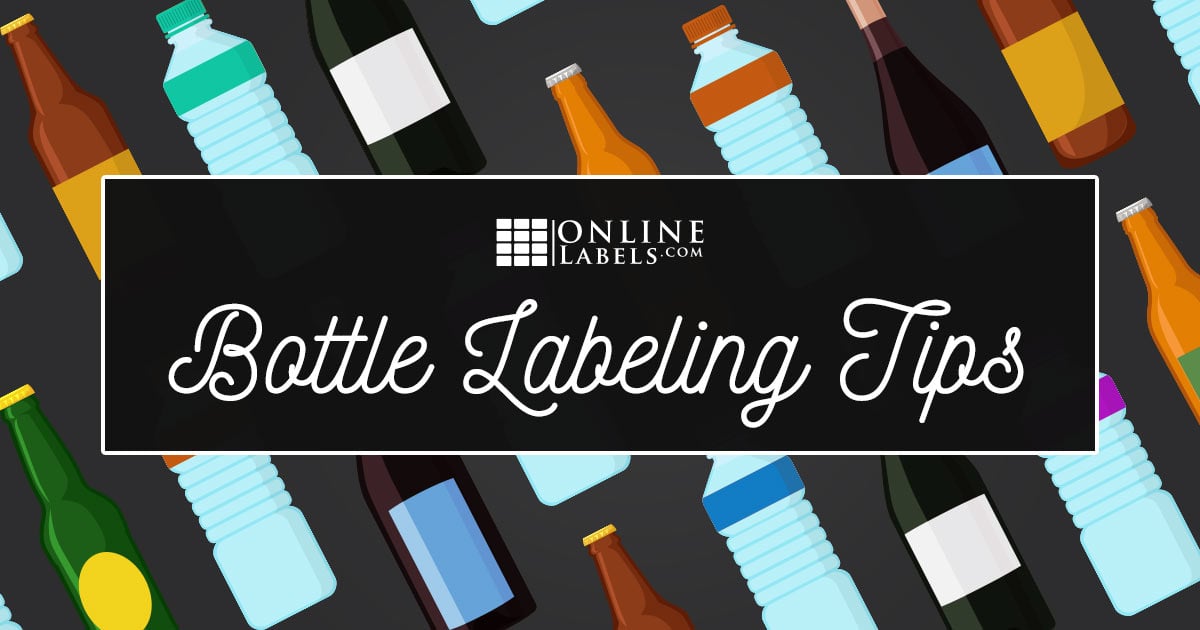How to Make the Perfect Bottle Label

Which sense is more powerful – taste or sight? Taste may keep customers coming back but sight is what drew them to your product in first place.
Take a look around next time you walk through the grocery store. While you may be overwhelmed by the sheer number of choices, did you ever notice that they all have their unique label styles? We're not only talking color or design, consider the shape and size of the label, too.
In this article, we share our best tips so you can create custom bottle labels. You can also follow along with our video.
1. Take your bottle's measurements
When it comes to labeling curved objects like bottles, it can be tricky to find the right size. To combat this difficulty, we created a printable ruler. Download, print, and cut out our printable ruler (make sure you're printing it at actual size). Wrap it around your bottle and record your bottle's dimensions.
Pro tip: If you're looking for a full-wrap label, add 1/4" to your end measurement so it overlaps at the back.
2. Pick a label for your bottle
Browse our curated selection of bottle labels. We recommend compatible label sizes and popular sizes for each of the standard bottle types. Once you click into a specific category, enter your measurements from Step 1 to narrow your options.
Labeling beer, specifically? Learn more about choosing the perfect beer bottle label.
To add more visual interest to your bottles, consider a neck label, which wraps around the upper part of the bottle. Shop blank bottle neck labels or enterprise solutions custom bottle neck labels for large quantity orders.
3. Choose a label material for your bottle
We want to help you find the best material and adhesive for your project. Read the two categories below to learn more about how your environment and surface should determine your label material.
Consider the Environment
If you're labeling water, beer, or white wine, there's a chance your bottle will end up in the fridge or a cooler. You want your label to stand up to whatever conditions it comes into contact with. Many of our labels are weatherproof / waterproof, so they're designed to resist water and keep your design looking great. For moisture and liquid protection, choose from these materials:
| Material Type | Material Description |
|---|---|
| White Matte | Our weatherproof white matte materials feature a bright white facesheet with a permanent adhesive. Both options (one for inkjet printers and the other for laser printers) are tear-resistant and can easily adhere to surfaces such as metal, plastic, and glass. Shop our waterproof matte inkjet bottle label material or our weatherproof polyester laser bottle label material. |
| White Gloss | The glossy facesheet of our white gloss labels will produce photo-quality results, perfect for designs with pictures. It's extremely water and tear-resistant and features a permanent adhesive. Shop our waterproof gloss inkjet bottle label material. |
| Clear Matte | This material features a durable facesheet with a powerful adhesive. Its frosted appearance is striking and can help elevate the look and feel of any bottle. Shop our clear matte laser bottle label material. |
| Clear Gloss | Get that "no-label look" with our transparent permanent labels. The permanent adhesive is extra strong and will stick to most surfaces. Plus, its special top coat won't let ink run, smear, or smudge when submerged in ice or water. Shop our clear gloss laser bottle label material. |
| Metallic Silver | Add a touch of elegance with the brushed silver finish on our metallic foil labels. The permanent adhesive backing is water-resistant and durable, ready to stand up to a night in the cooler or extreme temperatures. Shop our weatherproof silver polyester laser bottle label material. |
View our complete listing of label materials.
Consider the Surface
While it's probably inherent knowledge that labels stick differently to different surfaces, it's important when it comes to choosing an adhesive type. Ideally, the label adhesive and the destination surface have what's called good "wet-out". This term relates to the relationship between the adhesive and the surface. When the surface has high surface energy, the adhesive can spread over the destination's surface well, resulting in maximum contact and a strong bond.
Below, we break down the popular bottle surfaces, identify their level of surface energy (data from Data from UPM Raflatac), and make our material/adhesive recommendations for best results.
| Material | Surface Energy (dyn/cm) | Recommended Material(s) |
|---|---|---|
| Plastic | Very Low: 42 |
● Clear Gloss Laser ● Clear Matte Laser ● Weatherproof Gloss Inkjet ● Weatherproof Matte Inkjet ● Weatherproof Polyester Laser ● Weatherproof Silver Polyester Laser |
| Glass | Medium: 250-500 |
● Clear Gloss Laser ● Clear Matte Laser ● Weatherproof Gloss Inkjet ● Weatherproof Matte Inkjet ● Weatherproof Polyester Laser ● Weatherproof Silver Polyester Laser |
| Aluminum | High: 840 | All materials |
| Stainless Steel | Very High: 700-1,000 | All materials |
Get an in-depth understanding of surface energy.
4. Design your bottle label
When it comes to designing a bottle label, you may not know where to begin. Below are a list of resources you can use to get started:
- Launch Maestro Label Designer for an easy design and printing process.
- Download a blank label template for your preferred design program. We offer free blank label templates for each of our label products.
- Browse our pre-designed bottle label templates for professionally designed templates you can customize.
- Check out our article, 7 Design Sites You Might Not Know About.
- Learn more about the influence color has on our perception with this Color Psychology Infographic.
- Visit the Customer Ideas gallery to see what other bottle labelers have dreamt up.
5. Print or order your bottle labels
To produce high-quality prints at home, complete the following checklist. You can also order custom printed bottle labels on sheets or rolls. We offer both our white weatherproof and clear weatherproof materials when you choose to have your labels printed on rolls.
- Check on the amount of toner/ink left in your cartridge. As toner/ink levels deplete, you'll likely start to notice some discoloration.
- Modify the material setting (if necessary). Most of the time, the pre-set material settings will work for your needs. However, there are times when a special material setting may be required. View our material setting recommendations.
- Print at 100% size. You don't want your PDF viewer to scale down your artwork, that can mess with the alignment of your design on the label sheets. Deselect "Fit To Page" or "Auto Rotate and Center" in the printer dialog box.
- Clean your printer. Dust can affect how the labels feed into the printer and even cause paper jams or leave roller marks down your sheets. Test this by running a blank sheet of printer paper through first.
6. Apply your bottle label
Once you've made your bottle material and size selection, designed the label, and hit print, the next big step is to ensure the label is correctly applied to your bottle. The following steps are among the easiest and efficient ways to apply a label to a bottle.
- Place the bottle on a surface that won't allow it to roll. We've found that placing it in your lap and using your knees to hold the bottle securely works well.
- Carefully peel the corner of the label under the seam away from the protective backing.
- Grasp the label lightly on both ends and align to the label area on the bottle.
- Press the label onto the bottle at the center and smooth out to one side. Return to the center and repeat for the remaining side. (This will help with centering your bottle label and making sure it sits straight.)
- Smooth all the edges down to eliminate any air pockets or creases.
We hope this guide was helpful as you set out to create bottle labels that are not only appealing, but functional. Whether you're creating labels for water, beer, wine, events, parties, or business, our selection will ensure your products will shine.



